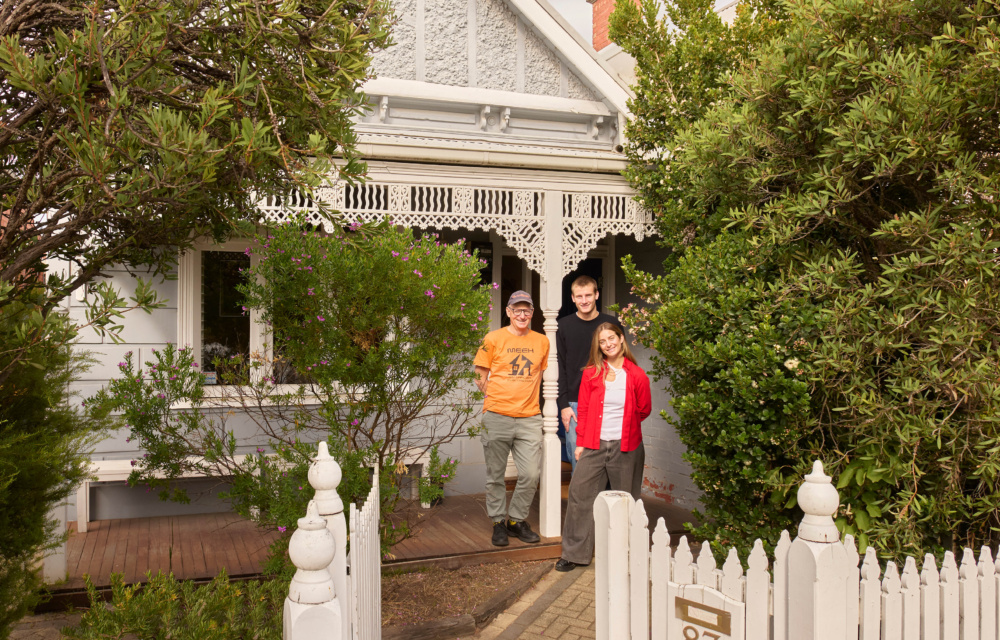Renter-Friendly Ways This Share House Can Save Money On Energy Bills
Climate
The Northcote home was renovated in around 2011.
A contemporary extension is hidden at the rear, where double-glazed windows and doors open to a deck.
The living room.
The sleek kitchen features a gas cooktop.
The house has central ducted gas heating and a single reverse-cycle split system in the living room.
Tim speaks with tenants Nicole Enriques and Noah Zawertailo about the home’s comfort.
A quick inspection of the gas ducted heating vents reveals they are missing filters.
Tim shows how to seal up a gap in the vents with draught tape.
A DampRid bag hangs in their wardrobe to collect excess moisture from the air in hopes of preventing mould.
Noah and Nicole’s bedroom.
Tim and the couple discuss an old gas bill.
Melbourne graphic designer Noah Zawertailo has been living in this Northcote rental for a few years, now sharing the Edwardian with his partner Nicole Enriques and housemates Lulu Gillard and Daniel Watson.
In comparison to many other rentals, Noah says the house is probably ‘above average in terms of comfort’, thanks to a renovation that added a modern extension to the back of the house in about 2011.
The home has three bedrooms with original period details at the front, and soaring ceilings with double-glazed windows in the updated living and kitchen at the back. This means it’s full of lovely natural light, and is comfortable in summer, autumn and spring. But in winter, the front can get ‘very draughty and chilly,’ Noah says.
Home comfort and energy advisor Tim Forcey shares how the rental property stacks up in terms of energy efficiency, along with what changes the renters could make themselves, and what’s worth raising with their landlord.
Heating and cooling
In addition to having an old gas ducted heating system, the house has a reverse-cycle air conditioning unit in the living room. Noah says the typical bi-monthly gas bill in winter costs them about $150, noting the household does try to avoid using the gas heating unless really necessary as this has resulted in higher bills in the past.
‘Our main concern is around being able to evenly heat both ends of the house throughout winter, without running up a massive gas bill,’ Noah adds.
Tim inspects the ducted air vents to find they don’t have a filter and have collected a lot of dust that is subsequently being blown around the home. The vents also have gaps in between, which he suggests sealing up with a draught tape to improve the efficacy. Even something simple like ensuring all the internal doors are open will help ensure the whole house benefits from the heating.
But regardless, a reverse-cycle split system is still the cheapest way to heat a home, costing about a third of the price as gas heating.
While the tenants can’t install one themselves, Tim says it’s worth speaking to the landlord to see if they would consider installing more split-systems to heat the front of the home — especially as the government offers rebates of up to $2940 to replace gas heating with these electric energy-efficient alternatives.
Draught proofing
The home is in fairly good condition for its age, but some cracks in the hallway walls and gaps around the front door are impacting its thermal performance. Tim says the housemates can caulk these up themselves as a form of draught proofing with permission from their landlord, which cannot be refused as per Victoria’s minimum standards for rental properties.
Another big reason for the cold and draughty conditions are the old fireplaces in the bedrooms. ‘You can use blocks of foam to stop hot air leaking out and cold air from blowing in. Ecomaster sells a Chimney Draught Stopper,’ Tim says.
Nicole is concerned about mildew forming in the bedroom and has recently started hanging a dehumidifying bag in her wardrobe to absorb excess moisture from the air. She’s finding these fill up quite regularly, and while some moisture in the air is normal, Tim suspects this is because steam from the nearby ensuite shower is leaking into the bedroom.
He says they could purchase a dehumidifier for about $200-$400 to improve the home’s air quality and prevent stains or mould — something that becomes more important if they draught proof, as this will further restrict air flow.
Insulation and windows
The insulation in the roof is also a bit ‘all over the place’ and is worth improving if the landlord is willing.
On the positive, Tim says it’s great that the floor-to-ceiling windows in the living room are double glazed and have solid blinds, as this helps to maintain a comfortable temperature in extreme heat or cold. Unfortunately, the bedroom windows are only single glazed.
Tim says a renter-friendly hack is to cover the windows in a layer of bubble-wrap to create a cheap form of additional insulation: ‘it still lets light in but makes a noticeable difference to preventing heat loss.’
Hot water
A gas-boosted solar thermal hot water system currently services the home. This combines a small solar panel array on the roof that can heat the water using renewable electricity, with a traditional gas water system which automatically turns on to supply hot water at night or whenever the sun isn’t shining.
Tim says these were very popular about 20 years ago, as it was one of the only renewable energy upgrades you could make at the time, but nowadays they are not very effective.
‘We often find the gas ends up doing all the work,’ he adds. Installing an electric heat pump is the most efficient system, however this would have to be actioned by the landlord.
Overall
Tim estimates the share house would fall in line with the average Melbourne home, scoring about a three out of 10 on the residential scorecard for efficiency.
‘The star rating is based on the cost of running the household, and while this home is relatively small it does have gas ducted heating.’
Next steps
All of the areas for improvement Tim outlined are very common problems that almost every homeowner we visited in this series is also grappling with. But the biggest issue here is really about the limitations placed on renters in how they can take control of their energy usage.
Tim says even getting a free energy monitor (subsidised by the Victorian Government) is a handy way for Noah and his housemates to gain a better understanding of their energy usage and work out what to prioritise in terms of costs.
Noah says they have plans to look into some of the DIY-draught proofing, in addition to notifying their landlord about the inadequate insulation in the roof. And they’ve already ordered an energy tracker!
Momentum Energy is 100% owned by Hydro Tasmania — Australia’s largest generator of renewable energy. Find out more about signing up to an energy retailer that supports the transition to renewables.

